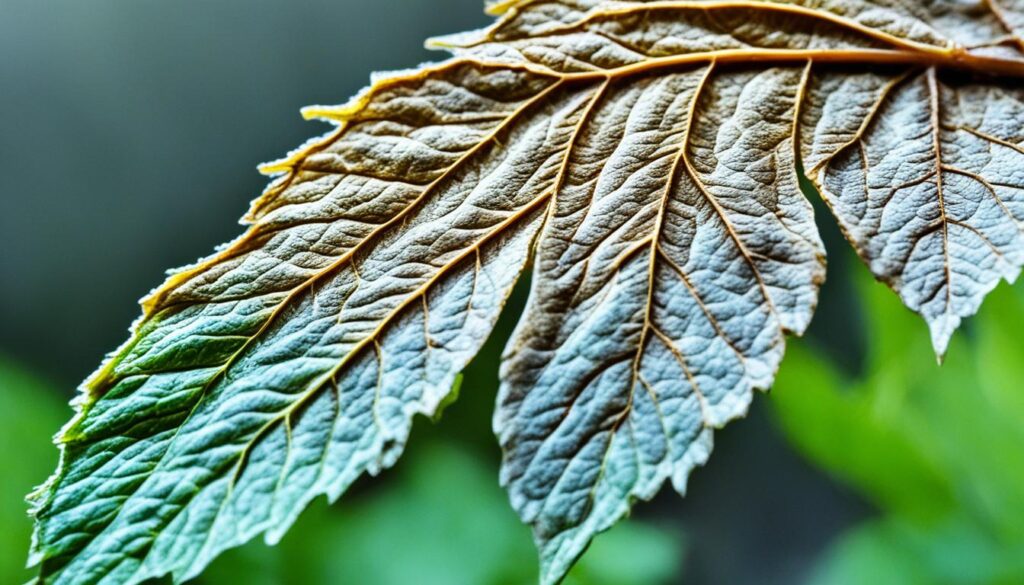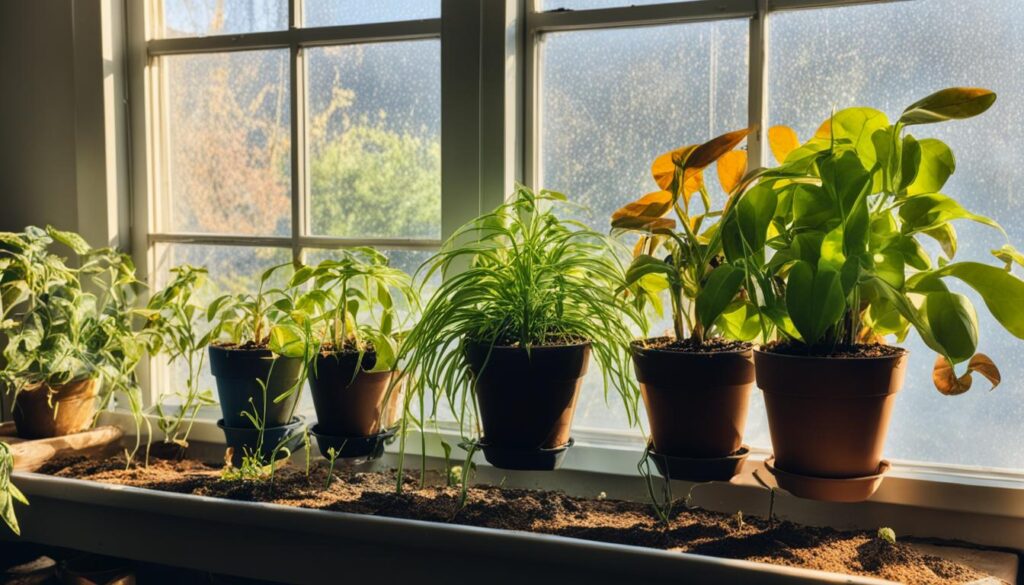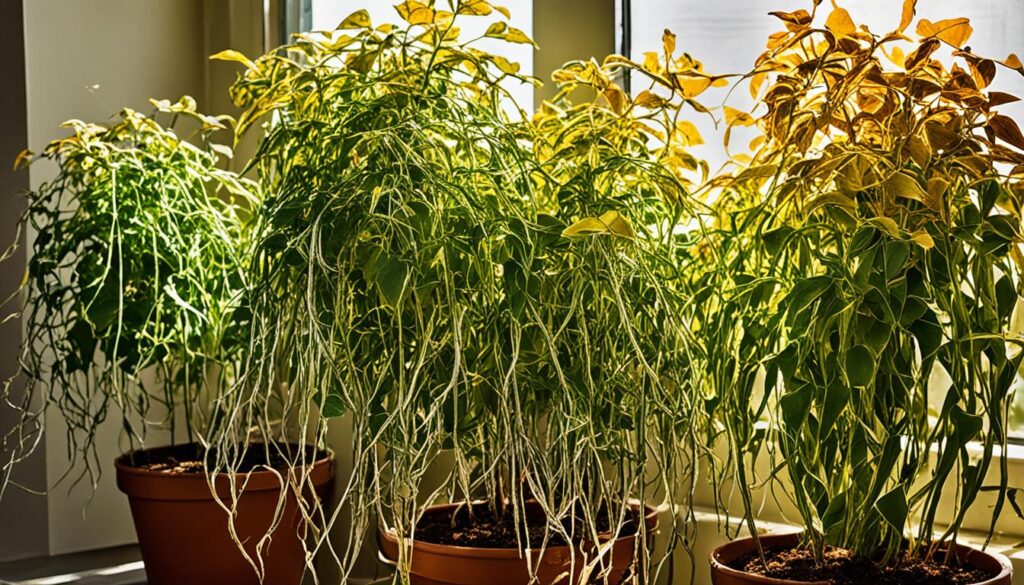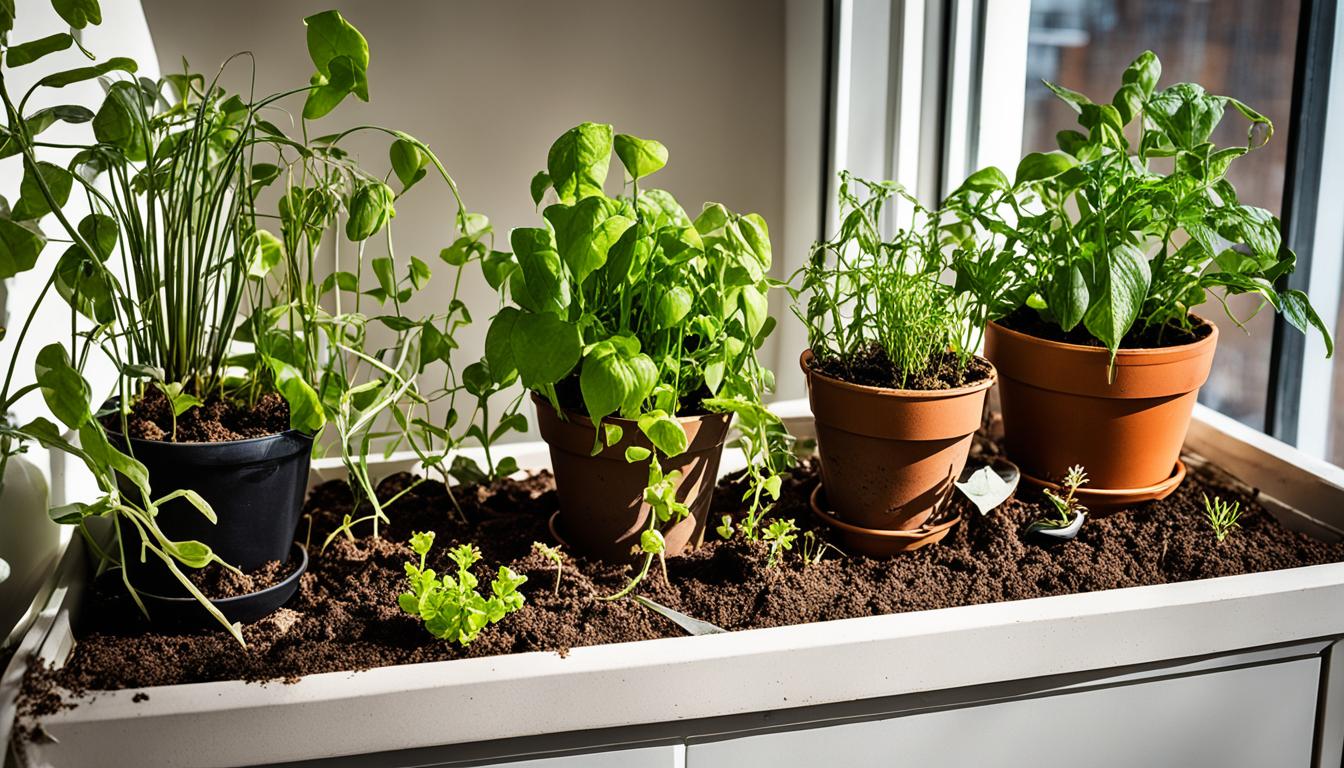Did you know plants in your apartment make the air better? They reduce stress and boost well-being. But sometimes, keeping them green and growing is hard. If you see overwatering, crispy leaves, or plants looking sad, I can help!
In this article, you’ll learn how to make your indoor garden great again. Whether you’re an expert or a newbie, this guide will help. You will know how to care for your plants and see their beauty.
Key Takeaways:
- Learn how to identify and address overwatering issues in your apartment plants.
- Discover the causes of browning and crispy leaves and how to restore your plants’ vibrant foliage.
- Understand the reasons behind leaf drop and how to prevent further damage to your plants.
- Find out how to promote healthy growth in your apartment plants and encourage them to thrive.
- Learn effective techniques to combat common bugs that infest houseplants and keep your plants bug-free.
Overwatering: First Aid for Houseplants
Overwatering is a big issue for people with indoor plants. If plants get too much water, their roots can’t get air. This hurts the plants and can make them sick. I’ll show you how to spot these problems and how to help your plants get better.
Symptoms of Overwatering
Yellow leaves, wilting, and root rot are signs of too much water. Roots drown and rot if they sit in water too long. They turn black, get soft, and smell bad.
Sometimes, plants look dry even if they’ve been overwatered. This happens when their roots are harmed and can’t take in water properly. The plant dries even when the soil is wet.
It’s important to see these signs early and act fast. Not fixing overwatering can kill your plants.
Click here to find a detailed table with signs and symptoms of overwatering.
Browning/Crispy Leaves: First Aid for Houseplants
Are your plant leaves turning brown and crispy? Don’t worry! I’ll share why this happens and how to fix it. Browning leaves can happen if you water too much or too little. Humidity and light are also important. I’ll tell you what to do to make your plants happy again.
Causes of Browning/Crispy Leaves
Watering your plants wrong can make leaves brown and crispy. Not enough water can make plants thirsty and their leaves dry and crispy. Too much water can hurt the roots and make leaves brown.
Humidity is also key for healthy leaves. Too little humidity makes leaves dry out fast. Too much can cause diseases and make leaves discolored.
Plants need the right light and water. Different plants need different amounts of light and water. Knowing what your plant needs helps keep its leaves green and healthy.
To fix browning and crispy leaves, here’s what to do:
- Check the soil’s moisture by feeling it with your finger. Water if it’s dry.
- Water your plants well. Make sure pots let out extra water.
- Keep your home’s humidity right. Use a humidifier or pebble tray if needed.
- Place your plants where they get the light they like. Some need bright light, others less.
- Look out for bugs that harm plants. Get rid of pests if you find them.
- If your plant is too big for its pot or the soil is hard, repot it.
Do these steps to fix browning leaves and your plants will be healthy again.

Dropping Leaves: First Aid for Houseplants
Reasons for Leaf Drop
Is your indoor garden losing leaves like autumn? This can mean your plants are stressed. Many things can make houseplants lose leaves. Knowing why helps you make your plants healthy again.
- Experience Stress: Like us, plants can feel stress. Things like moving or repotting can make leaves fall.
- Summer Months: In summer, plants often lose leaves. This is how they adjust to new seasons.
- Inadequate Light: Not enough light can cause leaves to drop. Make sure your plants get the light they need.
- Temperature Fluctuations: Big changes in temperature can stress plants. This can make leaves fall off.
- Rootbound Plants: Plants in small pots can become rootbound. Their roots have no space. A bigger pot can fix this.
- Environmental Stress: Dry air, drafts, or bad stuff in the air can hurt plants. They might lose leaves.
To stop leaves from falling, fix these problems. Your plants will grow better.
Plant Not Growing: First Aid for Houseplants
Is your plant not growing? This can be a real challenge. Yet, you can help it! We’ll explore reasons like not enough sunlight or nutrients. Also, when a plant’s roots can’t grow freely, it’s a problem. I’ll share tips on repotting and feeding your plant. With the right approach, you’ll see your plants grow.

Causes of Stunted Growth
Many issues can stop your plant from growing. It’s key to find and fix these problems. Now, let’s look at what could slow down your plant’s growth:
- Lack of sunlight: Plants need light to grow. Not enough light slows them down.
- Insufficient nutrients: Your plant needs the right food to grow. Without it, growth suffers.
- Root restrictions: If roots can’t spread out, the plant can’t get what it needs. This makes growth hard.
Understanding these causes helps us fix stunted growth. Let’s see how we can help your plant.
First Aid Techniques for Stunted Growth
Here’s how you can fix stunted growth:
- Provide adequate sunlight: Make sure your plant gets enough light. Use grow lights if you need to.
- Ensure proper nutrition: Check if your plant has all the nutrients it needs. Use good fertilizer or compost for health.
- Repot the plant: If roots are tight, give your plant a bigger home. This helps it get water and food better.
- Fertilize regularly: Feed your plants often. Use fertilizer as the directions say.
With these steps, your plants can grow again. Watch them and adjust care as needed. With love and effort, your inside garden will bloom!
| Cause | Symptoms | First Aid Techniques |
|---|---|---|
| Lack of sunlight | Yellowing or pale leaves Stretched or leggy growth |
Place the plant in a well-lit area Use grow lights if necessary |
| Insufficient nutrients | Pale or discolored leaves Poor overall growth |
Apply a balanced fertilizer or organic compost Follow the recommended dosage |
| Root restrictions | Circling roots Poor water drainage |
Repot the plant into a larger container Ensure the new pot has proper drainage |
Bugs: First Aid for Houseplants
Are bugs causing trouble in your indoor garden? These unwanted guests can seriously harm your plants if not treated. I’m here to show you how to spot and fight common houseplant bugs.
Common Bugs on Houseplants
Several bugs often attack houseplants:
- Fungus Gnats: These tiny flies hang around soil and like it wet. They eat organic stuff and harm roots.
- Aphids: These little bugs reproduce fast. They cover plants in sticky goo. They eat plant sap, making leaves twist and wilt.
- Spider Mites: These small pests aren’t spiders but are related. Hard to see, they make leaves yellow, dry, and dotted.
- Mealybugs: These white, fuzzy bugs gather on stems and leaves. They drain plant sap, leading to yellow, curled leaves and slow growth.
Now you know which bugs to watch for. Let’s look at how to deal with them and keep your plants healthy.
| Bug | Symptoms | Treatment |
|---|---|---|
| Fungus Gnats | Mini flies near plants, mainly by the soil. Leaves may yellow or wilt. | – Let soil dry before watering again – Use sticky traps for adult gnats – Use Bacillus thuringiensis var. israelensis (BTI) for larvae |
| Aphids | Small bug clusters on stems and leaves. Sticky goo on leaves. | – Spray plants with water to remove aphids – Use insecticidal soap or neem oil – Bring in ladybugs or lacewings |
| Spider Mites | Leaves turn yellow, dry, and spotted. Fine webs on plants. | – Mix water and dish soap to spray plants – Raise humidity around plants – Use predatory mites or ladybugs |
| Mealybugs | White, cottony bugs on stems and leaves. Sticky goo on leaves. | – Use rubbing alcohol on a cotton swab to remove bugs – Spray with neem oil or insecticidal soap – Introduce ladybugs or parasitic wasps |
With these steps and careful watching, you can control bug problems. Keep your houseplants thriving and bug-free!
Spindly Growth: First Aid for Houseplants
Is your apartment plant stretching towards the light? This might be because of not enough light. I’ll tell you why spindly growth happens. I’ll also give you tips to make your plants strong and healthy.
Causes of Spindly Growth
Several things can make houseplants grow spindly, such as:
- Light deficiency: Not enough light makes plants stretch, leading to weak, long stems. If they don’t get enough sunlight, think about using artificial lights.
- Incorrect watering: Too much or too little water can cause problems. It’s vital to find a watering schedule that works. Let the soil get a bit dry between waters.
- Repotting: Moving plants to big pots too early can make them grow long and weak. Only repot when needed. Make sure the new pot fits the roots well.
- Inadequate light: Besides not getting enough light, dim or uneven light can also cause issues. Make sure they’re in a spot with bright, indirect light all day.
- Overcrowding of plants: Plants too close together fight for light and space. This causes them to grow tall and thin. Give them room to grow nicely by spacing them out.
- Weak stems: Some indoor plants have naturally weak stems. You can help them by using supports like stakes or trellises.
Here’s how you can fix spindly growth and make your plants healthier:
- Make sure they get enough light, either natural or from grow lights.
- Water your plants just right. Not too much, not too little.
- Repot at the best time. Choose pots that fit their needs.
- Put them where they get steady, bright light but not direct.
- Give your plants enough space so they don’t have to stretch for light.
- Use supports for plants with weak stems. This will help them grow strong.

| Causes of Spindly Growth | Solutions |
|---|---|
| Light deficiency | Optimize light conditions by providing adequate natural or artificial light. |
| Incorrect watering | Ensure you are watering your plants correctly, avoiding both overwatering and underwatering. |
| Repotting | Choose the right time to repot your plants and select pots that suit their specific needs. |
| Inadequate light | Place your plants in an area with consistent and bright indirect light. |
| Overcrowding of plants | Space out your plants to prevent overcrowding and promote more vigorous growth. |
| Weak stems | Support plants with weak stems to prevent them from becoming spindly. |
Yellow Leaves Finger Test: First Aid for Houseplants
Your houseplants’ health links to their watering. Yellow leaves often mean water issues. The yellow leaves finger test helps you know if you’re watering right. This test checks soil moisture so you can water properly.
- Gently insert your index finger into the soil, down to about an inch or two.
- Pay attention to how the soil feels:
- If the soil feels dry, your plant may need water.
- A moist or wet soil means your plant has enough water.
- Excessively wet or soggy soil shows too much watering.
- Dry soil? Water your plant well and let extra water drain.
- If soil is moist, wait a bit before watering again.
- Wet soil means no water till it dries out a bit.
Use the yellow leaves finger test often to avoid too much or too little water. This keeps your plants healthy. Good watering helps plants stay green and lush!
| Common Problems | Causes | Solutions |
|---|---|---|
| Yellow leaves | Under or overwatering | Perform the yellow leaves finger test to determine watering needs and adjust accordingly |
| Browning or crispy leaves | Incorrect watering | Ensure proper watering techniques and monitor soil moisture |
| Drooping plants | Under or overwatering | Perform the yellow leaves finger test to assess soil moisture level and adjust watering as needed |
| Stunted growth | Insufficient watering or nutrient deficiencies | Provide adequate water and nutrients to promote healthy growth |
| Pests | Various pests such as fungus gnats, aphids, spider mites, and mealybugs | Implement pest control methods specific to the type of infestation |
| Spindly growth | Inadequate light and improper watering | Optimize lighting conditions and ensure proper watering techniques |
| Roots spilling out | Root overcrowding and insufficient pot size | Repot plants into larger containers and provide adequate room for root growth |
| Sad or droopy plants | Water stress and humidity issues | Monitor watering and humidity levels to provide optimal conditions for your plants |
Roots Spilling Out: First Aid for Houseplants
Do your apartment plants’ roots seem to burst out of their pots? This can cause a lot of problems. I’ll talk about why this happens, how to repot, and when to prune roots. Your plants will get the space they need to be healthy.
Addressing Root Spilling Out
Seeing roots come out of a pot means the plant is too big for it. This can stop the plant from getting nutrients, slow its growth, and make it get sick easily.
First, repot your plant in a bigger pot. Here are some key steps to repot:
- Pick a new pot that’s 1-2 inches wider. This gives roots room to grow.
- Carefully take the plant out, trying not to hurt the roots.
- Look at the roots for damage or rot. Cut off bad parts with clean pruning shears.
- Put some good soil in the bottom of the new pot.
- Put the plant in the middle and add more soil. Cover the roots well but not too deep.
- Water the plant well and let extra water drain away.
Choosing the right pot size is very important. A pot too small makes roots cramped. Too big, and you might overwater. Pick a pot that’s just right for the roots to grow.
Sometimes, you may need to cut some roots when repotting. This helps the plant grow new roots and stops overcrowding. Use clean shears to cut only the outer roots a little. This helps the plant not to get too shocked.
Sad/Droopy Plant: First Aid for Houseplants
Is your apartment plant looking sad and droopy? It might be because of water stress or humidity issues. I am here to guide you in helping your sad and droopy plant. We will talk about water requirements and humidity requirements. Also, we will explore misting techniques to keep the right moisture. Soon, your plants will look happy and healthy again!
Dealing with a Sad/Droopy Plant
When your plant looks sad and droopy, it’s important to act fast. Here’s what you can do to help:
- Check the moisture level: First, see if your plant has too little or too much water. Different plants need different amounts of water. Use the finger test to help you know if the soil is too dry or too wet. This will help you know how to change your watering habits.
- Ensure proper watering: After checking, change how often you water the plant. If it’s too dry, water it more. If it’s too wet, let it dry out a bit. The goal is to make your plant happy.
- Address humidity: Not enough humidity can make plants droop. You can fix this by putting a tray of water near your plant or using a humidifier. Misting the plant with water can also help. But, don’t mist plants with fuzzy leaves as it can harm them.
- Assess light exposure: Too much or too little light can also make plants droop. Make sure your plant gets just the right amount of light. Move it to a brighter place or give it some shade as needed.
- Check for pests and diseases: Bugs and diseases make plants weak and droopy. Look at the leaves and roots for signs of trouble. If you find anything, treat your plant right away using the right methods.
- Prune as needed: Cut off any parts of the plant that are dead, damaged, or sick. This helps the plant focus on growing healthy parts.
- Monitor temperature and drafts: Big changes in temperature or drafts can stress your plant. Keep your plant in a place with steady temperatures and away from drafts.
By doing these things and taking good care of your plant, you can help it be happy and healthy again!
| Water Requirements | Humidity Requirements | Misting Techniques |
|---|---|---|
| Find out how much water your plant needs and adjust your watering habits. | Keep the humidity right with a tray of water near the plant or a humidifier. | Mist plants that like it. Don’t mist plants with fuzzy leaves. |
| Watch out for giving too much water. It can cause problems. | Check the humidity often and change it to make your plant happy. | Use a spray bottle to mist your plant’s leaves evenly. |
Conclusions
Thank you for being with me on this journey. We explored how to care for your indoor garden.
We learned to fix various plant issues in your apartment. This includes first aid for plants to make them healthy again.
Now you know how to deal with too much water and browning leaves. You also know how to stop leaves from falling off. Plus, how to make plants grow healthy, fight bugs, get the light right, and water properly.
Taking care of your apartment plants is key. With care and attention, they will grow well.
With what you’ve learned, your plants can come back to life. You’ll have a lovely garden all through the year.
So, it’s time to get to work. Make your home green and full of life. Enjoy the calm and beauty of nature inside your home.


